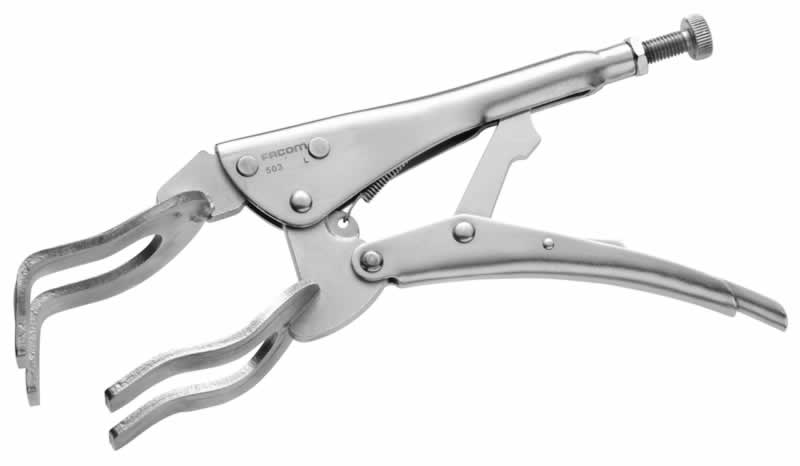
updated mechanism: removable housing for the half nut The new design (below) has a separate metal housing that is attached to the rear carriage with two bolts and this means the the half nut can be removed for cleaning even after the vice has been fixed to the bench. The second improvement is more useful: In the design from the 1920s the half nut is hidden behind the casting of the rear carriage and is inaccessible once the vice is fixed to the bench. I leave it to the reader to decide how much of a problem was caused by all the careless vice fitting going on in the 1920s, but suffice to say Record go on to acknowledge (in the same patent) that the problem was already solved by their ‘screw and nut cover’ (see previous section) which they invented several years earlier. There is, however, often a passage from the bench surface to the housing between the back of the plate like portion of the fixed jaw and the bench mortise in which it is let and this passage, especially in the case of faulty or careless work in erecting the vice on the bench ( GB409804 1923) You may wonder how a part of the vice that is fixed to the underside of your bench could be the cause of sawdust falling in and clogging the working parts – the answer is in the patent: The nut housing is usually provided with external flanges, lugs or the like by means of which the vice is secured to the under surface of a bench, the bench itself closing the housing. KEEP WORKING PARTS LUBRICATED some of the plates were engraved with the patent number (just about visible in the example above). SAWDUST EXCLUDER PLATE TO PREVENT CLOGGING OF MOVING PARTS This change was introduced at the same time as a modification to the housing for the half-nut and they put a blue and yellow sticker on the plates to explain the changes: The RECORD VICE has TWO IMPORTANT FEATURESġ. In November 1932 Record applied for a new patent, this time for a “sawduster excluder plate” that covers the housing for the half-nut. Version IV – sawdust excluder plate (1932) This must have been vulnerable to damage and it was reinforced in later versions (there was a corresponding change in the face plate with the inclusion of a slight bulge under the trigger). The new design (right) has a cut out on the face of the vice needed to accommodate the spring. An excellent idea.ġ920s quick release mechanism (left). In August 1927 Record took out a patent ( GB292381) for a “Screw and Nut Cover” – this is a metal cover that extends the length of the screw, preventing sawdust and shavings dropping on the thread. If enough debris builds up it can cause the half-nut to ride up the screw thread causing the mechanism to slip, potentially damaging the threads in the process. The first idea is actually rather good, but the second, described below, is a bit of a duffer (it does at least help with constructing a timeline for the vices).Ī weakness of Parkinson’s quick-release design – perhaps the only serious issue – is that the screw is exposed when the vice is opened and sawdust and any shavings that fall on the screw can be carried onto the half-nut. Version III – screw and nut cover (1927)Įventually Record came up with a couple of improvements that they considered worth patenting. The best we can say is that any of the vices with an RD stamp were made between July 1918 to 1933 or thereabouts.

Record take credit for introducing this improvement (see catalog entry below) but can’t claim to have had the original idea since, as we saw previously, WC Toles, a US maker, was using steel rods in his vices over 20 years earlier:

This was a better design and all the major GB manufacturers had switched to it (including Parkinson) by the 1930s. The cast iron sliders were comparatively fragile and the polished steel rods afforded a smoother mechanism. The new version improved on the previous model by the use of steel rods rather than the cast steel slides used in the copy of the Parkinson vice. 1918-1930 Version II – Steel Rods (1918)Ĭ&J Hampton, released a new version of the vice in 1918 and retained the ‘Record’ trademark. This may be a reference to older Woden vice design as it would be odd for Woden to sue C&J Hampton over their 1910 quick release vice which, after all, Woden had themselves copied from Parkinson after his patent expired. Woden tried, unsuccessfully, to sue, but the vises were unprotected by patent. Hampton Ltd, they brought the Woden line with them and began making vices patterned after Woden's. When Hampton's grandfather, Charles, and great-uncle, Joseph Hampton, moved to Sheffield in 1898 to start C & J. Tony Hampton, a distant relative of the founders of these two companies who had worked for the Woden business, told Scott Landis : Hampton's great-great grandfather, Joseph Hampton, started the Woden Company around 1870 in Birmingham. Woden catalogue 1918 - their Parkinson pattern vice is shown in the centre


 0 kommentar(er)
0 kommentar(er)
